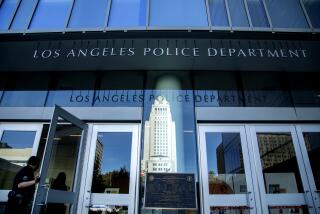Los Angeles Turning Points: Three Monumental Reforms
Los Angeles is deeply involved in three separate but related reform efforts that are of great significance. But amid the current bitter recession, which is taking its toll not only in jobs but in morale, the potential collective import of these unprecedented efforts is perhaps not fully appreciated. This is unfortunate, because if all three prove effective--not certain, to be sure, but more than possible--the current period may well be remembered by historians less for the economic recession than for an extraordinary period of civic rebirth. The city’s future thus rests to a great extent on the fate of these three reforms.
1. POLICE REFORM: No doubt the most nationally known of these efforts is the police reform mandate that arose in the troubled aftermath of the Rodney King beating case. That awful incident led to the resignation of a longtime L.A. Police Department chief, the appointment of former Philadelphia Police Commissioner Willie L. Williams as a replacement and the overwhelming approval, by voters, of the police-reform charter amendment in June, 1992. The jewel amid this often-bitter controversy, which raged again this month in the reaction to the lenient sentencing of Officers Stacey C. Koon and Laurence M. Powell, was the Christopher Commission report. Named after Warren Christopher, the Los Angeles lawyer who now serves as President Clinton’s secretary of state, that report provided the city with a sensible and workable plan for improving the LAPD.
Executing as much as possible of that program is essential to the city’s future. Quality policing helps elevate a city’s life; inept, racist or aloof policing only helps erode it. If the Christopher reforms come to maturity under the persistent professional efforts of Chief Williams, backed with enthusiasm and understanding by the new mayor, Richard Riordan, the next generation will inherit a superb Police Department. Conversely, a dilatory effort would be a sad betrayal of a great opportunity.
2. SCHOOL REFORM: The history of American public school reform is unfortunately not replete with success stories. Reform within the public sector is fiendishly difficult, as entrenched interests work to preserve their prerogatives and positions. That’s why the committed people behind the still-evolving LEARN reform effort already deserve honorable mention, no matter how much ultimately gets done, for generous amounts of patience, persistence and perseverance. The LEARN effort, like the police reform, is a serious and comprehensive stab at revitalizing the public sector from within. As noted, this isn’t easy.
LEARN aims to save the city’s public school system, not to destroy it as the random privatizing implicit in the proposed voucher system would do. Is this rescue still possible, with all the calls for breaking up the school district and for siphoning money out of public schools to underwrite private school vouchers? LEARN, led by former Assemblyman Mike Roos and a committed coalition of business and union leaders, civic activists and academics, is an extraordinary effort to work within the system, to build consensus among parents, teachers and everyone else; and to borrow and adapt from other U.S. areas those few reforms that have worked well.
The aim is to empower local schools, liberate teachers and engage parents in the education of their children. Its efforts work in tandem with the evolution of so-called charter schools, which are permitted to operate semi-independently from the central school district administration.
3. INNER-CITY REFORM: Although it took its share of criticism during its initial phase, RLA--Rebuild Los Angeles--has already done more for the future of inner-city economic development than any other entirely private-sector effort in civic memory. It draws on individual and corporate contributions--in money and staff time--and benefits from not one dollar of government support. It seeks to identify and fund inner-city businesses. In the 15 months of its existence, it has received commitments of $500 million in development money and begun helping scores of small business enterprises. The foundation is built; now it must bring investment and jobs to the inner city. With its new focus on small-business encouragement, RLA could prove a model of private-sector civic renewal. As RLA co-chair Bernard W. Kinsey has pointed out, no city has tried anything like it on this scale. If it succeeds, it will prove a historic, trail-blazing venture.
AMBITIOUS VISION: Few cities have had even one of these reform efforts in full bloom. Los Angeles has three. What does this say about the city’s energy, vision and commitment? It says a lot, indeed. But somehow Los Angeles seems tongue-tied, incapable of articulating its own extraordinarily ambitious vision of recovery and renewal. This failure of articulation only compounds the city’s image problems. But the oft-repeated picture of Los Angeles in decline is not just misleading, it misses a far more interesting and dynamic story.
More to Read
Sign up for Essential California
The most important California stories and recommendations in your inbox every morning.
You may occasionally receive promotional content from the Los Angeles Times.










